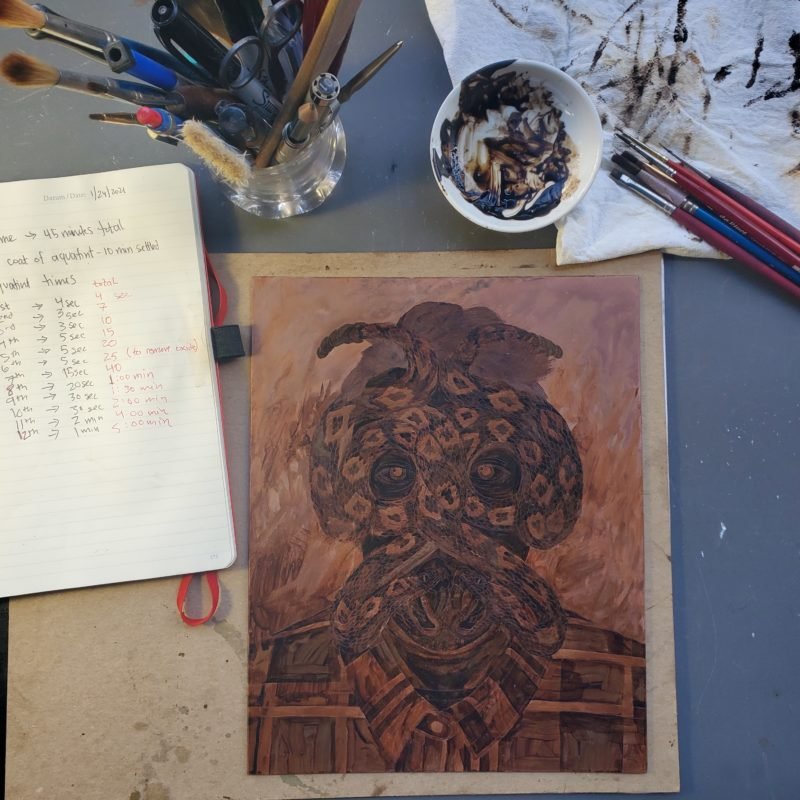Printmaking Techniques
Woodcut
Woodcut is a relief printmaking technique. This means that the surface of the wood holds the ink and the artist carves away the areas that will not hold ink. Studio woodcuts are carved out of shina plywood. This wood is exported from Hokkaido, the northern-most island of Japan. This wood carves very easily, holds sharp edges and it is practically grainless. This allows artists to carve in any direction without worrying about the direction of the grain in the wood.
Linocut
Linocut is also a relief printmaking technique. These type of prints are carved from linoleum, an industrial material used primarily to make flooring. This material is made from linseed oil and powdered cork. Linoleum is easy to carve and can be carved in any direction. However, due to the brittleness of the material, fine detail is not easy to achieve.
Reduction Relief Prints
These type of prints can be made with either wood or linoleum. Reduction prints allow an artist to work with multiple colors using one piece of wood or linoleum. Layers are created by carving away areas, printing the plate and carving again. An edition made using the reduction process cannot be replicated since the process of making the print destroys the matrix.
Mokuhanga
Mokuhanga is a traditional Japanese printmaking technique. Mokuhanga prints are made from wood and are printed using transparent water-based inks. The transparent ink is made from watercolor and nori paste, a natural slow-drying starch adhesive. Unlike Western woodcuts which are inked using a brayer, mokuhanga prints are inked using brushes. This allows several colors to be applied at one.
Intaglio
Intaglio is a family of techniques used to create prints on metal. Typically multiple intaglio techniques are used to create a piece. The studio uses copper to create intaglio prints and the primarily techniques include drypoint, etching, and aquatint.
Drypoints are created by carving directly onto the copper with an etching needle. The needle creates grooves in the copper called burrs that hold the ink. The burrs create a rich black soft line.
Etchings are made using an acid called ferric chloride. The surface of a plate is covered with an acid resistant coating made from asphaltum, rosin, and beeswax. An etching needle is then used to reveal the copper so that the acid bites into the plate. The time spent in the acid will determine the weight of the line. The line made using a hard ground is dense and sharp.
Aquatints are also made using ferric chloride. This technique allows the artist to create tones and shading that look like watercolors. The surface of the copper plate is covered with a fine layer of rosin that is melted onto the plate using a flame torch. The rosin is acid resistant and the time spent in the acid will determine the density of the ink.
State Proof 1, hard ground etching
State Proof 2, first aquatint
Bon à Tirer, second aquatint
Final Plate
Digital Chine-Collé
Chine-colle is a collage technique that uses thin colored paper to add color to a print without the use of multiple plates. Digital chine-collé uses inkjet prints printed on thin Japanese paper to add color to a piece. This technique blends traditional and digital tools and it allows the artist to create variations of a piece. Studio digital chine-collé prints are used making an Epson wide format printer with archival ultrachrome ink.
Gampi Chine-Colle
Gampi is a thin translucent Japanese paper made from the wild gampi bush that grows in the mountainous, warm areas of Japan and cannot be cultivated. This paper is considered the best Japanese paper for its strength and for its ability to capture the most subtle details. Intaglio prints using gampi chine-collé capture every detail in an aquatint. The thin paper makes applying the chine-collé difficult, however, the payoff is extraordinary.
















